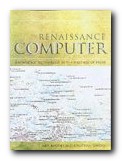information architecture in early print technology
The Renaissance Computer is a collection of essays which seek to explore the similarities, connections, and lessons to be drawn from a comparison of the advent of digital technology with the age of print in the immediate post-Gutenberg period. In the 15th century the printing press was the ‘new technology’. The first ever information revolution began with the advent of the printed book, enabling Renaissance scholars to formulate new ways of organizing and disseminating knowledge.
 The basic argument is that the proliferation of printed texts was as revolutionary and presented similar problems of information architecture, storage, and retrieval as we feel we have now in our digital age. The earliest attempts at memory and storage systems were remarkably similar to the Windows operating system, though the fact that they were made physically manifest made them cumbersome and non-portable. Nevertheless, it would have been wonderful to visit Giulio Camillo’s memory theatre, where a visitor occupied the stage, and all the knowledge of mankind was stored on the tiered rows of what would normally be seats.
The basic argument is that the proliferation of printed texts was as revolutionary and presented similar problems of information architecture, storage, and retrieval as we feel we have now in our digital age. The earliest attempts at memory and storage systems were remarkably similar to the Windows operating system, though the fact that they were made physically manifest made them cumbersome and non-portable. Nevertheless, it would have been wonderful to visit Giulio Camillo’s memory theatre, where a visitor occupied the stage, and all the knowledge of mankind was stored on the tiered rows of what would normally be seats.
Editor Jonathan Sawday looks at precursors of the modern computer in the work of Milton, Hobbes, Pascal, Liebnitz, and Descartes. There’s a chapter on the role of illustrations in early modern books, another looks at the role of the index, title page, marginalia, and contents page as early examples of hypertext and navigation.
The authors also point to the amazing persistence of some outmoded technological forms:
Recent work on the circulation of manuscript collections of poetry in the seventeenth century…has demonstrated that this form of publication survived for two centuries after the invention of the printing press. The modern researcher who, seated in the rare book rooms of the Huntington Library or the British Library, laboriously copies out passages from an early printed book is participating in an ancient tradition.
There is a very interesting (and more readable) chapter on Thomas Heywood’s Gunaikeion (1624), an encyclopedia on women. The link with computers is no more than the suggestion that it’s a cut and paste composition, but the content sounds so interesting it made me feel I wanted to read a copy.
These chapters are scholarly academic conference papers – and the have both their strengths and weaknesses. Wide ranging and well informed, but often looking for connections where none exist or finding them to little purpose.
The idea of a Renaissance computer is only a catchy idea. These studies are of how information was organised in text form, how it was understood and retrieved, and how the Renaissance book tackled issues of information architecture which many people now think of as something new.
© Roy Johnson 2002
Neil Rhodes and Jonathan Sawday (eds), The Renaissance Computer: knowledge technology in the first age of print, London: Routledge, 2000, pp.212, ISBN: 0415220645
More on information design
More on design
More on media
More on web design